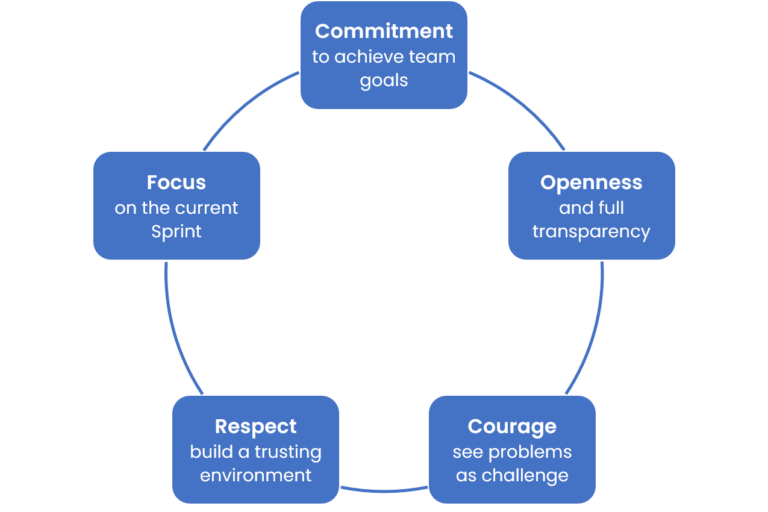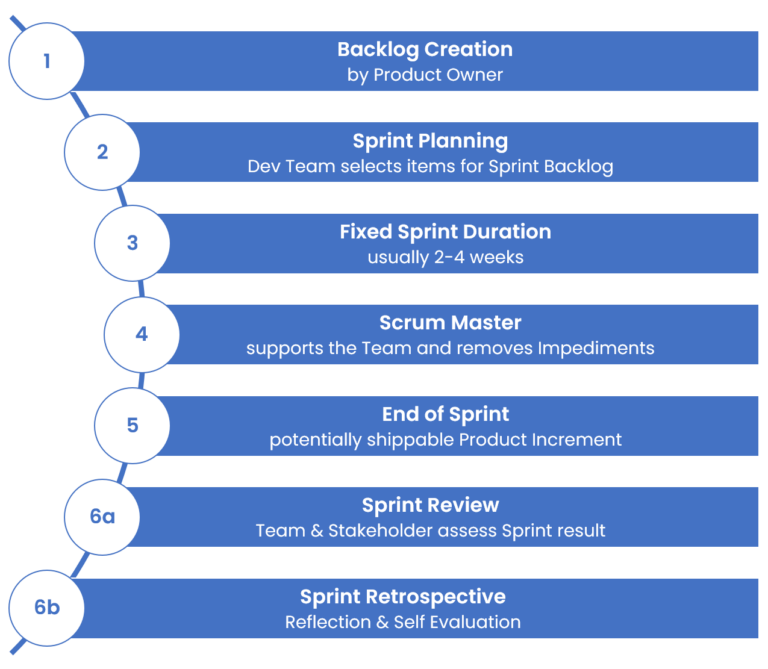
Scrum Overview
An Agile overview –
The most important Ideas & Terminology in a Nutshell
What is Scrum? How is it different?
Scrum is a framework for Agile Project Management. Contrary to “traditional” Project Management (think classical Waterfall or V-Model structure), you don’t need to have all the answers before you even start. With Scrum, you try to create results fast and learn from them – then you iterate on what you’ve learned.
The 3 pillars
Scrum is based on the theory of “empiricism.” The basic idea is to manage projects in recurring iterations, called sprints. In the process, findings are continuously collected and considered in the next cycle.
The pillars of success of Scrum are:
1. Transparency: all project information and results must be visible to everyone involved. Common standards help to avoid misunderstandings and ensure consistent interpretation.
2. Review: documents, work progress and processes are regularly checked to receive feedback at an early stage and to identify undesired deviations.
3. Adjustment: Based on the regular reviews, adjustments are made to prevent further deviations and to improve the work results or processes.
Scrum values for successful teamwork
The Scrum Guide emphasizes five core values that form the basis for effective collaboration in a Scrum team.

1. Commitment: all team members commit to working together to achieve team goals.
2. Openness: Transparency and open communication between the Scrum team and stakeholders are critical. Results and problems are shared openly.
3. Courage: Problems are viewed as challenges and approached with appropriate solutions. It is accepted that the future is uncertain, and adjustments may be necessary.
4. Respect: Treating each other with respect creates a trusting environment for learning and knowledge sharing.
5. Focus: All team members concentrate on the work in the current sprint and avoid tasks that do not contribute to the sprint goal.
These values may sound obvious, but in practice they can sometimes get lost in challenging project situations. Therefore, they have been deliberately included in the Scrum framework to emphasize their importance repeatedly. These values are not only relevant for Scrum teams but should also be guiding principles in other projects.
The Scrum cycle in a nutshell
The Scrum framework consists of various elements such as Scrum teams with their roles, events, artifacts and rules. We will cover each of those in detail as we go ahead.
A Scrum cycle usually follows this flow:

1. The Product Owner creates the Product Backlog, a prioritized list of tasks and features that describe the finished product.
2. During Sprint Planning, the Development Team transfers the highest-priority tasks to the Sprint Backlog for the next sprint and plans how they will be implemented.
3. The sprint has a fixed duration of usually 2-4 weeks (two weeks being the most common setup). During this time, the team works through the tasks in the Sprint Backlog and regularly meets for the Daily Scrum to discuss progress and obstacles.
4. The Scrum Master supports the team, ensures compliance with the processes, resolves ambiguities and removes obstacles to keep the team focused on the goal.
5. At the end of the Sprint, there is a deliverable, the Increment: a new feature, product, or other intermediate result that can be reviewed by stakeholders. Note that this increment should be potentially shippable (though that decision is beyond the scope of Scrum).
6a. The sprint concludes with the Sprint Review, in which the result is presented and assessed by the team and stakeholders.
6b. The Retrospective, in which the team reflects on the past Sprint and evaluates its own processes. Note that external stakeholders are not part of the Sprint retrospective – only the Scrum Team (Product Owner, Scrum Master, Development Team) gets to participate.
This cycle repeats until the Product is finished (the Product Backlog is empty) or it’s decided to cancel or halt any further Sprints due to scheduling or budgetary reasons (i.e. corporate reality kicks in).
The Scrum Team: Product Owner, Scrum Master and Developers
The Scrum team works together to achieve project goals, and each of the three central roles have different key responsibilities.
